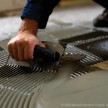Baseboard Radiators Not Heating Room Up
Hydronic Radiator Slant Fin Elements Facing Wrong Direction
Over the years I’ve had folks reach out to me complaining that they have rooms that do not heat up well. The solutions all varied; including zone valves, circulator pumps, relays, and whether the thermostat is working properly. Sometimes as simple as a battery needs replacing.
Slant Fin Elements Facing Wrong Direction
Recently I had two clients tell me they have to turn their thermostat up to 80 degrees just to get 68. One thing I never expected was seeing their radiator fins oriented horizontally versus vertical. In order to explain why I was perplexed lets briefly discuss how a slant fin baseboard element heats a room.
How A Hot Water Baseboard Heater Works
The boiler heats up water that is pumped through a copper pipe inside the baseboard housing. Attached to that copper pipe are aluminum fins. These fins heat up through conduction with the copper pipe.
Lower cool air, at the bottom of the radiator, is then heated by these fins as it rises up through them.
What Do the Aluminum Fins Do?
These fins act to increase the contact surface of the copper pipe with the surrounding air. The hot air rises [convection] because it is lighter than cooler air. The cooler air rises up and through the bottom of the baseboard, is wired by the fins, and this cycle continues until the thermostat is satisfied.
Baseboard Radiator Fins Facing The Wrong Way
When the fins are rotated so the vertical channels are horizontal, air flow is restricted, thus preventing convection through the radiator. These convector radiators require airflow in order to work and this orientation is similar to closing a damper.
Fixing the Problem – Rotating the Baseboard Pipe
There are several solutions that can correct this situation:
- Replacement
- Re-sweating, or cutting and coupling and then rotating the pipe
- Rotation the fins
- Bending the fins with needle-nose pliers to create an air channel

For this to work you will need to lift the radiator pipe and fins off the cradle brackets. There are plastic holders that hold the fins off the metal cradle brackets – remove these temporarily.
You Need Pipe Slack
Most fin radiators have some slack in the middle of the pipe, and less neat the elbow that go down under the floor. You NEED slack in order to have clearance to rotate the fins. You may find that you are NOT be able to rotate the fins near the elbows, due to lack of pipe movement. For those fins you may have to settle for bending them open with needle-nose pliers.
Personally, if the rotation method does not work for you, I would have a plumber try to unsweat the joint and rotate, or cut the pipe, add a coupling and rotate the radiator fins.
One thing that is worth mentioning is that dirty radiator slant fins can inhibit air flow. Read more on How To Clean Radiator Fins.

Simplest, Most Cost Effective Fix
I have had excellent success rotating the fins, which are attached through a “resistance fit” to the copper pipe. If you chose to rotate the fins, try following these steps:
- Rotate the fins when the pipe is cold.
- Use two 2” x 5″ strips of wood
- Hold two boards on top and bottom of the fins and rotate them 90 degrees.
- Wear gloves, as these fins are sharp.
- Use a needle nose plier to help with individual fins or if the wood plank method is too difficult.
Problem Solved
In both situations we rotated the fins and the clients immedietely noticed that the room heated up faster than it used to, and the thermostat did not need to be turned up higher than needed.
Remember, if the rotation method does not work for you, I would have a plumber try to un-sweat the joint and rotate it, or cut the pipe, add a coupling and rotate the radiator fins.
Either way you need to change the orientation of those fins!













